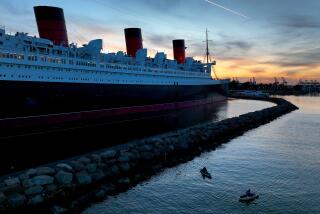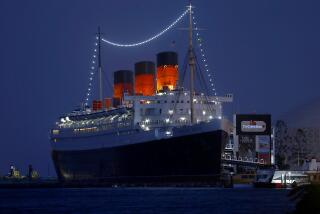Model Shipbuilders Show Work Aboard Queen Mary
- Share via
Bill Wicks became a shipbuilder in a roundabout way, drawn in by the dreams of a cancer-stricken neighbor.
Wicks had just returned from service in Vietnam when he and his wife moved to Culver City in 1965.
“There was a fellow who lived next door who went to sea as a cabin boy on a lumber schooner when he was 9 years old,” recalled Wicks, a barber who now lives in Garden Grove. “He had cancer and he was building a model of the lumber schooner he first went to sea in.
“He asked me if he didn’t finish, could I please finish it and give it to the Cabrillo Beach Museum . . . for his legacy.”
The neighbor died before finishing the model. Wicks’ passion began.
This weekend, you can see Wicks’ current project--the 100-gun British man-of-war, HMS Prince--aboard the Queen Mary in Long Beach, where more than 265 mostly wooden ship models are displayed as part of the biannual Western Ship Model Conference and Exhibit, Ship Modelers Assn.
The three-day conference, the nation’s largest, has drawn about 210 modelers.
Hours today are from 10 a.m. to 5 p.m.; admission is $6, $4 for children.
The key draw for the modelers is the seminars, which can be deadly dull for non-modelers. Modelers, though, insist the seminars are fascinating, with titles like “Model-Making as a Method of Scientific Inquiry” by Albert Hoving, curator of ship models at the Reijksmuseum in Amsterdam; and “Using Fiber Optics to Examine the Interior of Ship Models” by Simon Stephens, curator of the British National Maritime Museum.
The exhibits might be models, but they’re a far cry from the plastic-and-glue kits stocked on toy store shelves. Wicks’ 1670 HMS Prince is 4 feet long and still a work in progress, even though he has invested more than 100 hours of labor.
“There are over 6,000 wooden pegs in the hull,” said Wicks, 58. “The brass guns are all wax-cast, and made with the crest of the gun maker, and they’re exactly to scale. That’s what makes modeling so interesting--it’s the idea of duplicating something exactly, in a smaller scale.”
Pride lies in the details. The most respected of the modelers adhere to a strict code of historical accuracy, so the ships often are built from copies of original blueprints. That means the modeler must find the blueprints--not always an easy task.
And the blueprints usually contain design flaws that made sense on the drawing board but not in the shipyard.
Records rarely are kept on how shipbuilders converted the plans, with all their flaws, into working ships.
And most of the shipbuilders themselves are long dead. Meetings of the Ship Modelers Assn., held in Placentia, give modelers a chance to display works in progress, seek each other’s advice and get members out of their miniature shipyards.
Wicks runs the rookie league of ship modeling, the Mayflower Group, which attracts about 15 people to its monthly meetings.
“A ship made of wood is one of man’s greatest creations,” Wicks said.
“It had to weather storms and all types of elements and yet it was a place of refuge.
“There were ships of war and mercantile ships, and they were absolutely fabulous, just beautiful creations.”
Bob Beach, 73, of Brea, has advanced well beyond the Mayflower stage. He built his first model as a child, put it aside as he worked construction for 44 years, then resumed his hobby in retirement.
Yet he finds himself doing less model-building these days than talking. He has gathered a small group of enthusiasts who give ship presentations to schools and civic groups.
Beach is displaying his current project, a cutaway of the John Hancock, this weekend, even though it’s still incomplete after 163 hours of work.
“It’s a long way from being done,” he said. “If I were to finish it, it would take me working eight hours a day another year and a half. And I never get eight hours a day.”
More to Read
Sign up for The Wild
We’ll help you find the best places to hike, bike and run, as well as the perfect silent spots for meditation and yoga.
You may occasionally receive promotional content from the Los Angeles Times.







